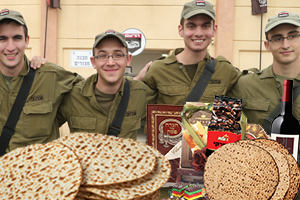Here’s some basic – and not so basic – information about Purim. Learn about the history and the meaning behind this joyous, yet very significant, holiday.
By Amb. (ret.) Yoram Ettinger, The Ettinger Report
Purim and deliverance. Purim is one of the Jewish national liberation holidays, such as Passover and Chanukah, which commemorate the transformation of the Jewish people from slavery and subordination to liberty and independence. It is celebrated, annually, at a time when the relatively dark and stormy winter shifts into the relatively warm and pleasant spring.
5th century BCE Queen Esther, the heroine of Purim. Purim’s Scroll of Esther is one of the five Biblical Scrolls: Song of Songs, Ruth, Lamentations, Ecclesiastes, The Scroll of Esther).
Esther, who was Mordechai’s niece (or cousin), demonstrates the centrality of women in Judaism, shaping the future of the Jewish People, as did Sarah, Rebecca, Rachel and Leah (the four Matriarchs), Miriam (Moses’ older sister), Batyah (who saved Moses’ life), Deborah (the Prophetess, Judge and military leader), Hannah (Samuel’s mother) and Yael (the warrior).
Esther was one of the seven Biblical Jewish Prophetesses: Sarah, Miriam, Deborah, Hannah, Abigail, Huldah and Esther (Megillah tractate, 14:71). Sarah was the first – and Esther the last – Jewish woman mentioned in the Bible. Sarah lived 127 years and Esther was the Queen of 127 countries. 1+2+7=10, which is a symbol of totality, wholesomeness, completeness.
The name Esther was a derivative of Ishtar, the Mesopotamian goddess of beauty and fertility, as well as Stara, the Persian morning star – which shifts darkness into light, thus becoming a symbol of deliverance – evolving into Aphrodite and Venus, the Greek and Roman goddesses of love, beauty and fertility, and Noga – a Biblical divine light and the second-brightest star in the night-sky after the moon (as well as, the name of my oldest granddaughter).
The name Esther (אסתר) could also be a derivative of the Hebrew word הסתר , “to conceal” – reflective of the initial concealment of her Jewish identity. In fact, Esther’s original Hebrew – Hadassah (myrtle tree with medical properties) – was changed in order to conceal her Jewish identity. At the same time, the Hebrew word for “scroll,” מגילה, derives from מגלה – “to reveal,” since Esther decided to reveal her Jewish identity in a thundering, game-changing manner.
Furthermore, God is concealed in the scroll of Esther, which is the only Biblical book that does not mention God. However, while God’s name is hidden/absent in Esther’s Scroll, Michael Bernstein suggests that the Esther Scroll makes 182 references to “King,” corresponding to 26 (the numerical value of Jehovah in Hebrew) times 7 (days of creation).
The Nazi-Haman parallel. “Purimfest 1946” yelled Julius Streicher, the Nazi propaganda chief, as he approached the hanging gallows (Newsweek, October 28, 1946, page 46). On October 16, 1946, ten convicted Nazi war criminals were hanged in Nuremberg. An 11th Nazi criminal, Hermann Goering, committed suicide in his cell.
The Biblical Scroll of Esther (which tells the story of Purim) documents Persia’s King Ahasuerus allowing the Jews to defend themselves and hang Haman and his ten sons, who were about to annihilate the Jewish people. According to the Talmud (Megillah tractate, 16a), Haman had an 11th child, a daughter, who committed suicide upon witnessing the demise of her father and brothers.
The late Eliezer Cotler, a Jewish Holocaust survivor who was my relative, told me that Julius Streicher’s library, in his ranch (which served as a camp for young Jewish survivors on their way to Israel), indicated Streicher’s conviction that the Purim saga was relevant to the fate of the Nazi regime. Hence, the yelling: “Purimfest 1946!” Streicher underlined, in red ink, each historical reference to the Amalekites and Haman, noting that the origin of the Aryan race was in Iran. Moreover, Haman was a member of the Agagite clan, named after Agag who was a king of the Amalekites – the most lethal enemy of the Jewish people since the Exodus from Egypt.
The Torah Portion (Deuteronomy 25:17-19) – which commands the remembrance of the Amalekite’s attempt to annihilate the Jewish people – is read in synagogues/temples on the Sabbath preceding Purim.
Purim highlights the self-destructive fate of peoples and regimes, who intend to annihilate the Jewish people, as has been demonstrated from ancient times, including the demise of the Nazi regime and the Stalin regime.
The Mordechai-Haman Clash of civilizations. The Purim saga represents the physical and spiritual clash of civilizations between the values of Mordechai and Haman. The numerical value of the Hebrew spelling of “blessed Mordechai” (ברוך מרדכי) and “cursed Haman” (ארור המן) is identical, 502, cautioning us that evil can easily misrepresent itself as benevolence.
A similar clash of civilizations/values – between right and wrong, liberty and tyranny, justice and evil, truth and lies – has taken place between nations, communities and within each person. For example, Adam/Eve vs. the snake, Abel vs. Cain, Abraham vs. Sodom and Gomorrah, Jacob vs. Esau (the grandfather of Amalek), the Maccabees vs. the Assyrians, the Allies vs. the Nazis, the West vs. the Communist Bloc and the Free World vs. Islamic rogue regimes and terror organizations.
The politically incorrect Mordechai. Mordechai, the hero of Purim, exposed an attempt to topple King Ahasuerus, and became the King’s top advisor, analogously to Joseph, who became the top deputy of Egypt’s Pharaoh. As a result of Joseph’s advice, Egypt was spared economic calamity.
Mordechai influenced the King’s decision to allow the resettling of Jews in Zion, the reconstruction of the Temple and the restoration of the wall around Jerusalem.
Mordechai, one of the deputies of Ezra the Scribe, led a wave of Jewish ingathering from Babylon to the Land of Israel, and was a role model of principle-driven optimism in defiance of colossal odds, in the face of a super power and in defiance of the Jewish establishment. He fought Jewish assimilation and urged Jews to sustain their roots and return to their Homeland.
Mordechai was an out-of-the-box thinker and a retired military commander, who preferred a disproportionate pre-emptive offensive to retaliation, appeasement and defense. The first three Hebrew letters of Mordechai (מרדכי) spell the Hebrew word “rebellion” (מרד). Mordechai did not bow to Haman, when the latter was the second most powerful person in the Persian Empire.
Mordechai was a descendant of King Saul. Both were members of the Jewish Tribe of Benjamin, the only son of Jacob who did not bow to Esau, just like Mordechai who did not bow to Haman. However, King Saul defied a clear commandment to eradicate the Amalekites, sparing the life of Agag, the Amalekite king, thus precipitating further calamities upon the Jewish People. Consequently, Saul lost his royal position and his life. Mordechai learned from Saul’s crucial error and eliminated Haman, a descendant of Agag the Amalekite, thus sparing the Jewish People a major disaster.
Purim’s historical background. The 586 BCE destruction of the First Jewish Temple (on Jerusalem’s Temple Mount), and the expulsion of Jews from Judea and Samaria, by the Babylonian Emperor, Nebuchadnezzar, triggered a wave of Jewish emigration to Babylon and Persia, which eventually replaced Babylon as the leading regional power. In 538 BCE, Xerxes the Great, Persia’s King Ahasuerus, the successor of Darius the Great, proclaimed his support for the reconstruction of the Jewish Temple and the resurrection of national Jewish life in the Land of Israel, recognizing Jerusalem as the capital of the Jewish Homeland. In 499-449 BCE, Ahasuerus established a coalition of countries, which launched the Greco-Persian Wars, attempting to expand the Persian Empire westward. However, Persia was resoundingly defeated (e.g., the 490 BCE and 480 BCE battles of Marathon and Salamis), and Ahasuerus’ authority in Persia was gravely eroded.


Send Passover Packages to Needy Israeli Soldiers - Bring Them Joy!
We are honored to thank the young men and women of the IDF who risk their lives every day to protect the citizens of Israel. Since October 7th, soldiers have been on the battlefield for months - many are hoping to come home for Passover.
Join us in sending Passover food packages (and personal notes) to Israeli soldiers and their families.
Many soldiers spend the Passover holiday with needy families back home. The soldiers greatly appreciate your love and concern. Bring them Passover joy!
CLICK HERE TO SEND YOUR PACKAGE AND NOTE TO ISRAELI SOLDIERS!




